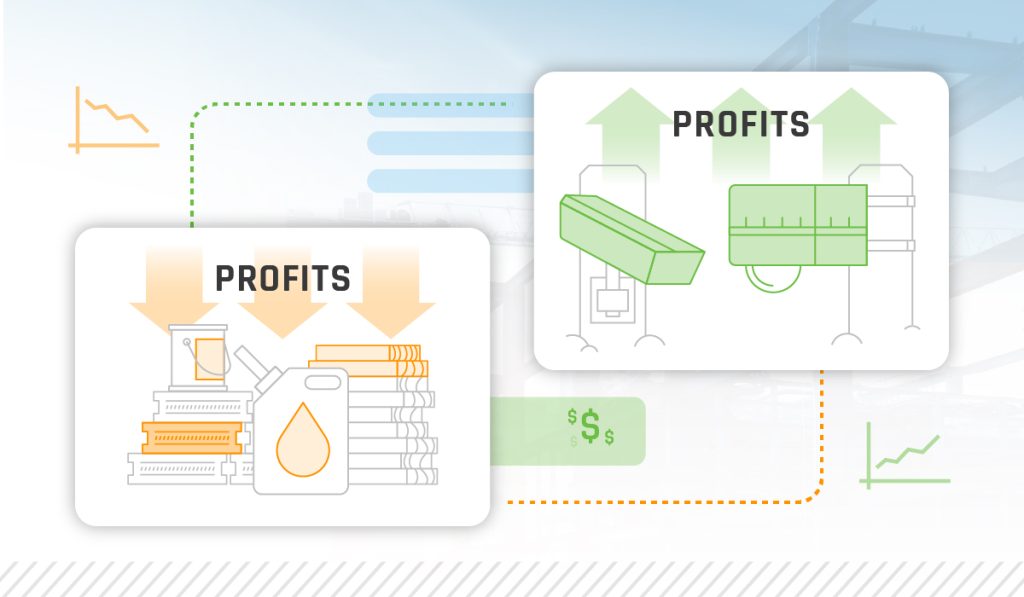
A recent article in ConstructionDive suggests “soaring” material prices in the aftermath of the Covid-19 pandemic and related supply chain disruptions may hinder construction firms from capitalizing on the expected project uptick throughout the rest of 2021. Despite the latest Associated Builders and Contractors’ Confidence Index indicating that employment, billings and backlogs are all on the rise, inflated material prices will likely impact profits, making economic recovery from the previous year more challenging.
Since the beginning of 2020, lumber prices increased 73% while iron and steel scrap went up by more than 50%. Crude oil which is used in paint, drain pipes, roof shingles and flooring materials is up by more than 80% since October 2020. As a result, total residential construction material prices have continued to climb further in 2021, increasing by almost 12.4% in the past twelve months as reported by the National Association of Home Builders.
Higher material prices have been plaguing construction firms for the past several years, but the pandemic sent the increase into overdrive. In addition, U.S. trade tariffs and other trade restrictions, implemented by the Trump administration and still in place under the current administration, impact nearly every type of construction material.
Not only are building materials more expensive, they are also harder to come by and once ordered, take longer to arrive. With limited access to required materials, delayed deliveries and higher costs, firms must look for ways to cut costs and operate more efficiently if they expect to turn a profit and finish projects within their clients’ desired time frames.
While rising materials costs will continue to inflate the overall cost of construction, increasing operational efficiencies on the jobsite and in the back office can help offset the added materials costs. Additionally, better forecasting and logistics can help firms meet project timelines.
Construction Cameras Enable Time and Cost Savings
In addition to providing added security on the jobsite, construction cameras offer a number of benefits that help firms stay on-budget and on-schedule:
- Remote viewing: Remote viewing eliminates travel, since project managers, owners and other stakeholders can sign in and view the jobsite remotely at any time. This saves firms significant time and money, improving margins. Remote viewing also improves logistics. With up-to-date information about the progress of a project, project managers can be sure crews are ready for incoming materials as soon as they arrive. If materials are late, they can call in other trades to start earlier and reschedule work according to the new delivery date.
- Better collaboration. Having construction cameras onsite improves collaboration and speeds decision-making. Project managers can review, mark-up and share images and video from jobsite cameras with stakeholders to help with adjusting scope and budget. They can also use those visuals to collaborate with superintendents and foremen throughout construction. Crews don’t have to sit idle waiting for directions when there’s an issue to be resolved or a critical decision to be made before construction continues.
- Smart forecasting. With access to visual documentation of a project from start to finish, project managers can get a sense for whether the project is progressing as expected and adjust subcontractor start dates for various phases of construction well ahead of time — before the project falls behind schedule.
- Back-office efficiencies. Visual documentation speeds up back-office processes that can potentially impact schedules. Advanced camera systems will automatically upload all visual documentation to a cloud-based repository for permanent storage and easy retrieval, eliminating many time-consuming manual tasks and simplifying compliance with policies and industry regulations. This also comes in handy if work is stalled due to a security or safety incident since project managers can quickly and easily locate visual proof of compliance for investigators or auditors.
- Reduced theft. Once those expensive materials arrive on your jobsite, the last thing you want is for them to be stolen. The presence of cameras on the jobsite has been shown repeatedly to reduce theft. And, if any of those precious, hard-to-come-by materials are stolen from the jobsite, firms have visual proof to hand over to the police and increase their odds of recovering the stolen goods.
More Room in Your Budget
By boosting efficiency in nearly every area of operations, construction cameras save firms valuable time and reduce operational costs — that adds dollars back into the budget to offset the impact of rising materials costs. With integrations to popular project management software such as Procore, PlanGrid and Autodesk as well as a rich feature set and cloud-based storage, TrueLook Construction Cameras are the most advanced in the industry. They come in a variety of form factors to suit any type of construction site.
Learn more about TrueLook cameras by watching a live demo. You may also enjoy reading this case study featuring Brixmor Property Group, who uses our cameras to cut costs, reduce travel, improve collaboration and simplify compliance.


